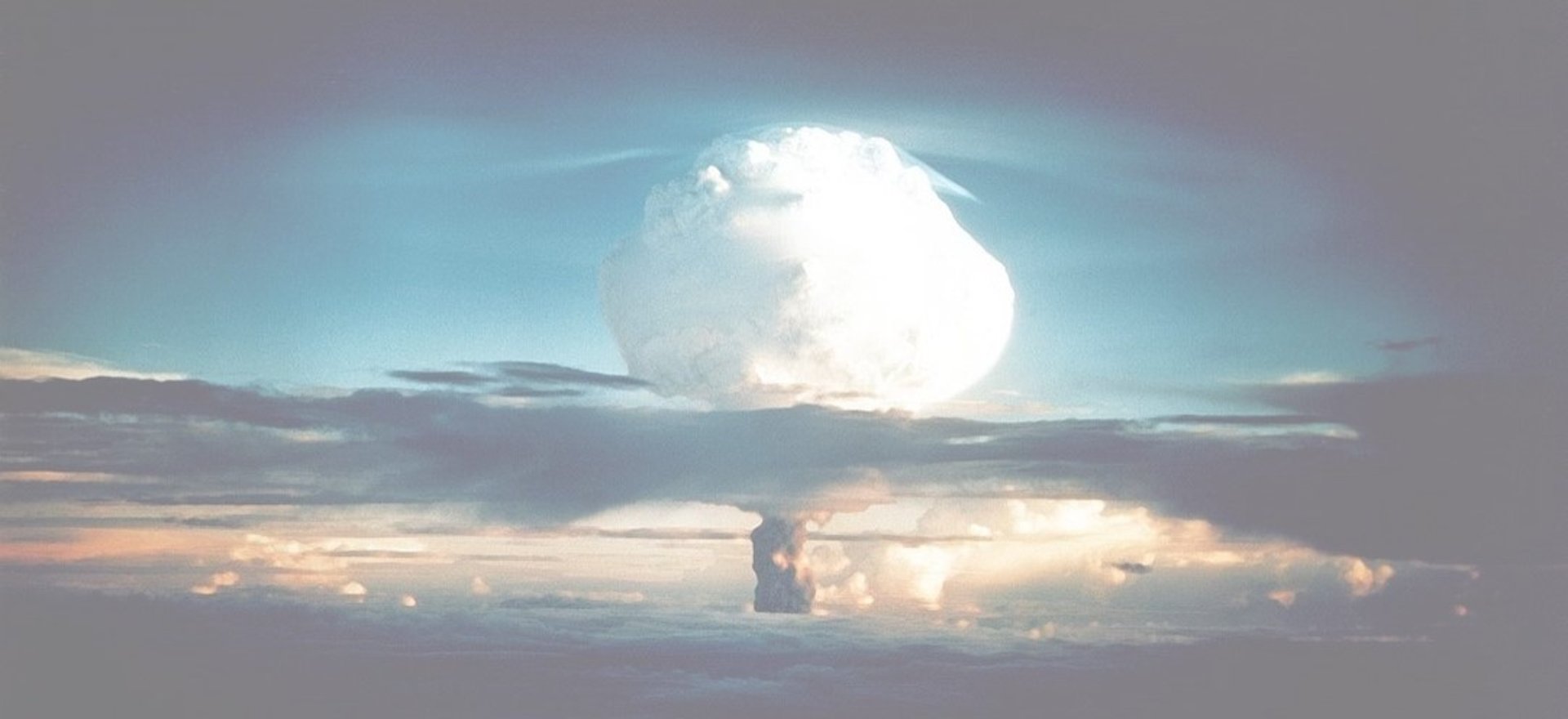
How Nuclear Weapons Shaped the Cold War And Guaranteed Peace
Nuclear weapons cannot destroy the planet, and even combining all the nuclear weapons in the world falls far short of annihilating humanity. In fact, having one more nuclear weapon in hand is a guarantee of peace.
全文在本站的词条
Little John Khan & CathayViews (Trans. & Ed.)
6/18/202315 min read
In the 2020 China Military Power Report released by the United States, it declared that China has 200 active nuclear weapons, and that this number will double within the next 10 years. However, this report clearly underestimates the scale of China's nuclear arsenal, since the capacity of intercontinental missiles displayed at the National Day military parade in 2019 far exceeded 200 nuclear warheads.
Hu Xijin(胡锡进), then editor of the Global Times, said the U.S. underestimation was a deliberate lie aimed at reducing the impact of China's nuclear deterrence on U.S. policy and setting a base for possible future nuclear disarmament.
When it comes to the number of nuclear weapons, most netizens think that it is meaningless because they believe that nuclear weapons would bring about doomsday and destroy the world altogether. They think that whether the earth is obliterated once or ten times does not make any difference. However, this view is very wrong. Nuclear weapons cannot destroy the planet, and even combining all the nuclear weapons in the world falls far short of annihilating humanity. Only by understanding this point can people understand that the quantity of nuclear weapons not only has meaning but also significant importance.
I will discuss this issue in several parts:
1. The Birth and Development of Nuclear Weapons
On August 6, 1945, the little boy was parachuted to Hiroshima, Japan, 60,000 houses within 14 square kilometers were completely destroyed, and the 6,000 degree heat melted everything on the spot, more than 70,000 people died on the spot, and the bones of the people in the new area were not left, leaving charred shadows on the ground. Three days later, the fat man gave the same treatment to Nagasaki. 100,000 people were killed or missing in the fire.
On August 15th, Japan surrendered unconditionally. After Japan's surrender, the United States realized that it had the most powerful force in the world. However, they also knew that this advantage could not be monopolized. Therefore, the US representative called for all nuclear materials to be supervised by the United Nations. The Soviet representative scoffed at this, saying that handing them over to the United Nations was essentially handing them over to the US for supervision. The US and the Soviet Union engaged in a war of words for four years. On August 29, 1949, the Soviet Union detonated its first nuclear weapon, codenamed "Joe I" in the West. "Joe" was Stalin's nickname. The war of words between the US and the Soviet Union ended at this point. In 1953, Julius and Ethel Rosenberg were sentenced to death on charges of espionage by the US. The US believed that these two people secretly provided information about nuclear weapons to the Soviet Union. They were executed by the electric chair.
One theory is that the Rosenbergs leaked the information on purpose, in order to maintain the nuclear balance of the world and break the US monopoly on nuclear power. After the explosion of the first Soviet nuclear weapon, the balance of world power was restored to equilibrium, and Stalin joked that if we had tested it a few years later, such a bomb might have fallen on us. For this new weapon, the US and the Soviet Union did not figured out how to use it properly. Although the atomic bombs at that time has unprecedented power, they were still much weaker than hydrogen bombs, and no wonder they could not destroy the earth. In those years, US officials believed that the atomic bomb should be used on the battlefield. In fact, they have seriously considered using nuclear weapons during the Korean War.
After the Soviet Union possessed nuclear weapons, in order to ensure its nuclear superiority, the United States accelerated the speed of manufacturing nuclear weapons. In 1950 the Soviet Union had five atomic bombs, the United States 369; In 1953, the Soviet Union had 150 atomic bombs, the United States had 1,436, and the American advantage was still enormous. At this time, the US officials were still considering a nuclear strike as one of several options, because it had a huge nuclear advantage, with far more nuclear bombs than the Soviet Union. And the United States was blessed with a location where it did not have to worry about its security until 1957, when an invention radically changed the rule of war.
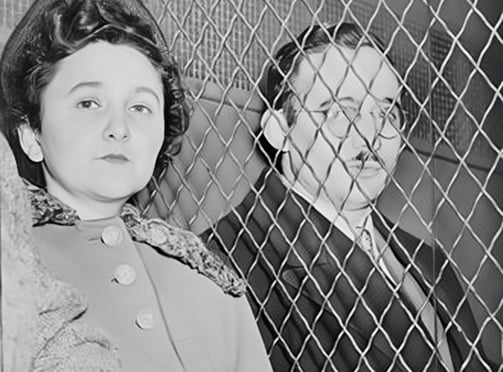

Julius and Ethel Rosenberg.
Image from Wikipedia. For more, see
https://en.wikipedia.org/wiki/Julius_and_Ethel_Rosenberg
2. Mutually Assured Destruction between the US and the Soviet Union
After the birth of intercontinental missiles, the United States began to seriously consider its nuclear strategy and no longer viewed it as an option to be used at any time. The concept of wars between nuclear states became a taboo topic that everyone avoided. In past wars, regardless of how fierce the fighting was, the leaders sitting safely in the rear - presidents, kings, and marshals could send millions of people to the battlefield to fight while commanding from behind the lines. The casualties on the front lines were just numbers to them. However, with intercontinental missiles carrying nuclear warheads, everything could be destroyed within an instant. Capitals, major cities, riches, and command centers all became potential targets. Those in high positions may have become even more vulnerable than civilians. The existence of nuclear weapons made all war-mongers reassess their situations and brought about a complete change in the logic of war. Under the pressure of death, the attitudes of the US and the Soviet Union towards nuclear weapons changed; they believed that the more weapons they had, and the larger they were, the better off they would be.
By 1960, the United States had more than 27,000 nuclear weapons, and in 1962 the Soviet Union produced the most insane product in human history, the Czar Bomba (also known as Tsar Bomba).
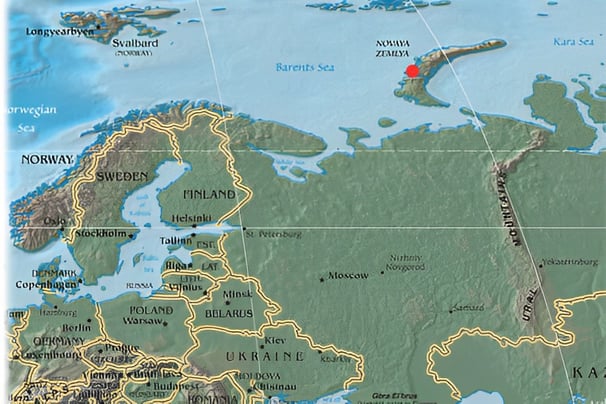

Site of the detonation of the Tsar Bomba.
Image from Wikipedia. For more, see
https://en.wikipedia.org/wiki/Tsar_Bomba
The Czar Bomb was the world's most powerful hydrogen bomb, originally designed to have an explosive yield of 170 million tons of TNT, but because there was no suitable test site on Earth, the yield was constantly reduced, and eventually only 60 million tons were left, and the test site was ultimately chosen in the Soviet Union's Novaya Zemlya. The mid-air explosion of the Czar Bomb produced a fireball 4,600 meters in diameter, resulting in a mushroom cloud up to 64 kilometers high, more than seven times the height of Mount Everest, which could be seen 1,000 kilometers away. The shock wave of the nuclear weapon wiped out every forest and house for ten miles around, shattered Window glasses in Finland, and caused an earthquake of with a Richter magnitude of more than 5. After years of development, the destructive nature of nuclear weapons has increased rapidly, which directly affects nuclear strategy.
For both sides of the Cold War in the 1960s, it didn't make much sense to talk about offense or defense when using such weapons. So the United States and the Soviet Union developed essentially the same nuclear strategy for the use of nuclear weapons: mutual destruction assurances. The so-called mutual destruction guarantee means that a country has the capability of first nuclear strike and second nuclear strike. A preemptive nuclear strike capability means that a country's nuclear weapons can be effectively delivered onto enemy territory. But even more important is a secondary nuclear strike: after surviving the enemy's pre-emptive nuclear strike, it is also capable of launching a secondary nuclear strike capability to destroy the other side. Having a secondary nuclear strike force is crucial in a nuclear war, if there is no secondary nuclear strike capability, one is very likely to be overwhelmed by the enemy's nuclear weapons. The availability of a second-strike nuclear capability thus determines whether an enemy government will restrain its desire for all-out nuclear war.
To achieve this goal, the US and the Soviet Union developed a triad nuclear strike capability with three dimensions: intercontinental ballistic missiles based on land, strategic nuclear submarines in the ocean, and strategic bombers in the air. Among them, nuclear submarines and strategic bombers are difficult to locate, making secondary nuclear strikes crucial.
After the Cuban Missile Crisis of the 1960s, the terrified Americans sent B52 strategic bombers to patrol with nuclear bombs. For 365 days a year, 24 hours a day, multiple strategic bombers were patrolling over North America with nuclear weapons at all times. If the Soviet Union launched a surprise attack, these bombers could be redirected and go straight to the Soviet Union. Naturally, the Soviet Union was not to be outdone. They built Typhoon-class strategic nuclear submarines larger than cruisers. Russian nuclear submarines have always been a nightmare for NATO, and they still guarantee Russia's status of a global great power today.
"Nuclear missile password" is a term that sounds very advanced and is frequently seen in spy movies. In everyone's imagination, the nuclear missile password must be very complicated. However, during the Cold War, the US kept their nuclear missile password as eight zeros for more than a decade. What’s more, to prevent input errors, the Americans removed all other keys on the keyboard except for zero. The reason why the nuclear missile password was so simple was to ensure that in the event of a Soviet attack, there would not be sufficient time to enter complex passwords before launching the missiles. In short, to ensure the ability to mutually destroy each other, both the US and the Soviet Union went to extremes.
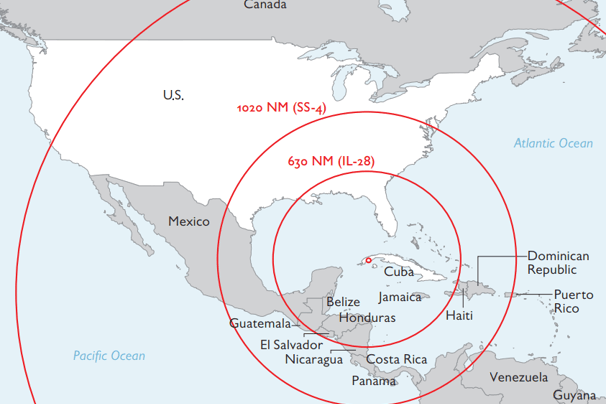

The area threatened by Soviet missiles during Cuba Missile Crisis.
Image from Wikipedia. For more, see
https://en.wikipedia.org/wiki/Cuban_Missile_Crisis
3. Nuclear Deterrence
By the 1970s, with the advancement of technology, the US and the Soviet Union established a nuclear missile warning mechanism, and their understanding of nuclear weapons also deepened. The Cold War entered its most terrifying phase because, with the improvement of civil defense facilities and continued nuclear testing, both the United States and the Soviet Union reevaluated each other's threats, and nuclear weapons were reintroduced as an option on the table.
After the 1970s, the mainstream thinking of the US and the Soviet Union's nuclear strategy changed to "nuclear deterrence," which means "winning the next nuclear war."
Yes, nuclear war is not the end of everything, and nuclear war can be won! Since no nuclear war has occurred between nuclear states since World War II, ordinary people subconsciously believe that a nuclear war would inevitably lead to the destruction of humanity. However, this is not the case. Although the power of nuclear bombs is destructive, it does not have the ability to destroy the entire human civilization as people imagine.
Among many statements about nuclear weapons destroying the world, the most well-known one is the nuclear winter theory, which claims that nuclear weapons would send dust into the atmosphere, causing a sudden global drop in temperature and ultimately leading to the destruction of mankind. After being repeatedly validated by scientists, this claim has been proven to be groundless because the amount of dust produced by nuclear weapons in the atmosphere is not enough to suppress global photosynthesis. Every 100 billion tons of nuclear weapon equivalents can blow up 25 billion cubic meters of rock and soil, which is only twice as much as the dust generated by the Krakatoa volcanic eruption in 1883, which only lowered global temperatures by 0.6 degrees Celsius. Furthermore, the total amount of current global nuclear arsenals is only 6 billion tons of equivalent power. In reality, compared with the power of nature, the power of nuclear weapons appears minuscule.
The 1980 eruption of Mount St. Helens produced an energy equivalent to 350 million tons of TNT, the equivalent of seven Czar bombs or 27,000 Hiroshima atomic bombs, and volcanic eruptions of this magnitude are just a daily occurrence in the Earth's movement.
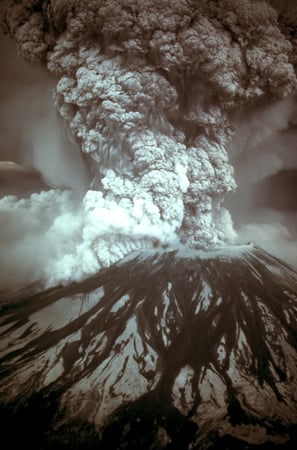


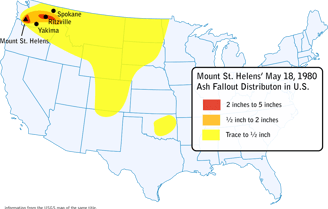
1980 Eruption of Mount St. Helens and its direct influence.
Image from Wikipedia. For more, see
https://en.wikipedia.org/wiki/1980_eruption_of_Mount_St._Helens
Apart from the explosive power, in terms of nuclear contamination, the nuclear radiation produced by nuclear weapons is far less than that of a nuclear power plant accident, making it a relatively clean weapon. Within 48 hours after an airburst nuclear explosion, the radioactive material will rapidly decay to less than 1%, and the explosion site will not become a wasteland. The pollution caused by nuclear bombs is far less than that caused by nuclear power plant leaks. Therefore, we see that Hiroshima is still a big city today, but Chernobyl is still a no-man's land.
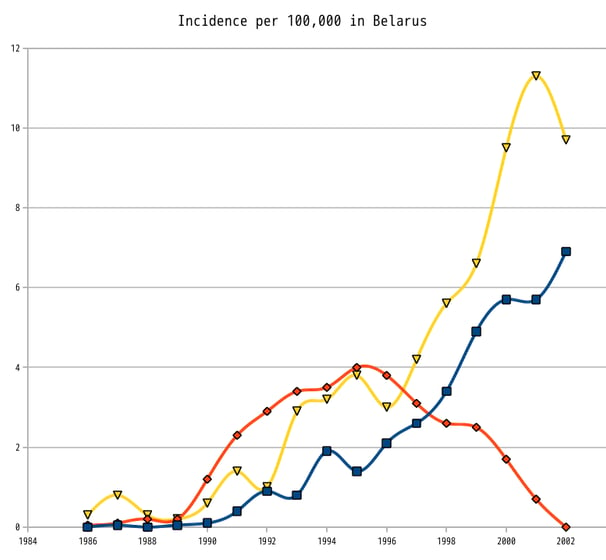

After the Chernobyl disaster, the Thyroid cancer incidence in children and adolescents in Belarus.
— Adults, ages 19 to 34
— Adolescents, ages 15 to 18
— Children, ages up to 14
Image from Wikipedia. For more, see https://en.wikipedia.org/wiki/Chernobyl_disaster
Regarding the range of destruction caused by nuclear weapons, even if we consider the most terrifying nuclear weapon, the Czar Bomba, with an explosive yield equivalent to 50 million tons of TNT, the radius of its destructive range for shelters is 27 kilometers, and for brick and stone buildings it is 55 kilometers. However, it cannot be guaranteed that people inside shelters beyond 55 kilometers will be affected. Such terrifying power of the Czar Bomba is still not enough for countries like the United States, the Soviet Union, and China, which have vast territories. In countries with well-equipped civil defense facilities, it is impossible to rely on nuclear bombs like the Czar Bomba to cover the entire country.
Concerns about the threat of a tsunami being generated by the deployment of nuclear weapons in the sea are unfounded. During the Cold War, the United States conducted multiple nuclear tests in the Pacific Ocean, but even the detonation of giant nuclear bombs with yields of tens of millions of tons on the ocean floor only generated tsunamis of a few millimeters in areas hundreds of kilometers away.
According to the United States' estimate in 1975, in the event of a full-scale nuclear war between the US and the Soviet Union, the US would lose 50% of its population and industry, but its productivity would recover to pre-war levels within 10 years. The Soviet Union had a similar estimate. Therefore, in the mid-Cold War period, the US and the Soviet Union gradually realized that nuclear weapons had tremendous destructive power and would cause unprecedented and heavy damage to their countries, but they were not enough to destroy their countries and the world. After a nuclear war, some countries would still maintain their dominance. Therefore, in the 1970s, the US nuclear strategy standard was that even if it suffered a full and perfect first strike from the Soviet Union, it could still destroy 30% of the Soviet Union's population and 75% of its industry, ensuring that the Soviet Union would suffer unacceptable losses while still maintaining a large number of usable nuclear weapons to deter nuclear countries like China.
The Soviet Union's nuclear strategy was similar to that of the United States, that is, even after suffering a nuclear attack from the US, it could still make the US suffer huge losses, while the remaining nuclear weapons could maintain an advantage over Europe and China. Under the dominance of nuclear deterrence thinking, the nuclear arsenals of the United States and the Soviet Union expanded to a terrifying level. By the late 1970s, the total number of nuclear weapons in the United States and the Soviet Union was close to 60,000, and the existence of these 60,000 nuclear weapons was not to destroy the world, but because both sides understood that nuclear weapons could not destroy the world and they needed to keep enough nuclear weapons for use after the war.
The nuclear strategies of the US and the Soviet Union also confirmed the absurdity of nuclear entanglement strategies. In fact, all nuclear-armed countries during the Cold War were trying to preserve their nuclear arsenal as much as possible to ensure they had bargaining chips after a nuclear war, and to achieve this, they had to minimize their opponents. Therefore, the nuclear strategies of each country were aimed at ensuring their ability to launch a second nuclear counterattack after a nuclear war, rather than behaving like a mad dog biting indiscriminately.
In the early 1980s, US President Reagan announced the Star Wars program, which greatly stimulated the Soviet Union. The Star Wars program referred to the interception of nuclear weapons from the Soviet Union through the establishment of a missile defense system. Influenced by this program, the Soviet Union's nuclear arsenal reached its peak of 40,000 missiles in the 1980s, raising the level of human nuclear power.
Don't think that nuclear war is far away from us. For half a century, both superpowers have been seriously considering the tactics of nuclear war.
4. Limited Nuclear Deterrence
However, for other countries in the world, the strategy of superpowers like the United States and the Soviet Union fighting each other is completely unattainable. Other countries either do not have enough territory or do not have sufficient funds. Therefore, during the Cold War, other countries such as the United Kingdom, France, and China adopted a "Minimum Nuclear Deterrence" strategy, which means they did not pursue attacking the enemy's nuclear and military forces, but only sought to inflict unbearable damage on the enemy's territory.
Due to not having to consider attacking the opponent's nuclear power, these countries need far fewer nuclear weapons, with a few hundred nuclear weapons being sufficient. For example, the UK's nuclear strategy has long been based on the Moscow criterion, which means that as long as the UK's nuclear power is strong enough to destroy Moscow, it can deter a nuclear attack from the Soviet Union.
Since China acquired nuclear weapons in the 1960s, it has maintained a Minimum Deterrence Strategy and kept a small nuclear arsenal, which is enough to deter countries that may want to attack China. This approach has been maintained for 60 years, and it has been effective in making other countries wary of attacking China.
Therefore, Western media has long believed that China's nuclear arsenal should be around 300-400 warheads. However, China's display of nuclear power during the 2019 military parade suggests that China's nuclear weapons may be far greater in number than previously estimated, but we do not yet know if there is a difference in magnitude.
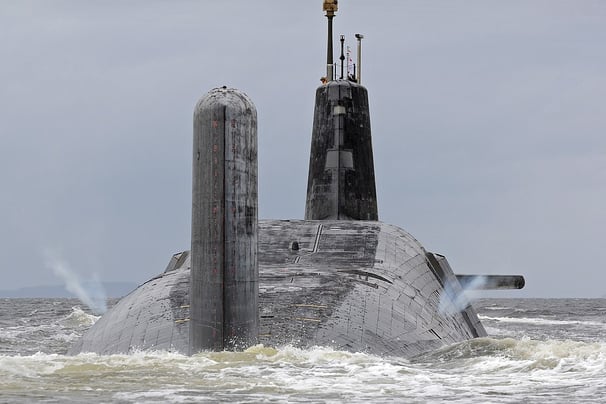

Even obeying the Moscow Criterion was too expensive to the British. So they decided to buy missiles from the United States and use their own submarines to keep their nuclear forces.
Image from Wikipedia. For more, see
https://en.wikipedia.org/wiki/Polaris_(UK_nuclear_programme)
5. China's Nuclear Strategy: Past and Present
The Minimum Nuclear Deterrence has ensured China's peace and security for the past few decades, but this policy may no longer be applicable to the current world.
The minimum deterrence theory is based on the assumption that the enemy believes that the cost of attacking is not proportional to the benefits gained from attacking, and therefore will give up nuclear strikes. During the Cold War, China, Britain, and France were in the second camp, and this strategy could ensure their own security. However, such a successful strategy may not necessarily guarantee China's security today.
From the perspective of the current situation in 2020, the United States has identified China as its number one competitor, and it is clear that China cannot continue to adhere to its policy of minimum nuclear deterrence. If the United States' nuclear capabilities can only destroy Moscow or the Soviet Union's nuclear capabilities, or only destroy New York, the Cold War will not last for half a century, because for both sides of the Cold War, the cost of such destruction is still worth the benefits of defeating the opponent.
And during this epidemic, the super resilience shown by the United States is truly surprising the whole world. When a president says that 200,000 deaths is "we did the great job", perhaps a greater cost is also acceptable for them.
Currently, the United States and Russia both have around 6-7,000 nuclear weapons, which is a relatively high number compared to China's recent proposal to increase its nuclear arsenal to the level of several thousand. Therefore, the idea of expanding nuclear weapons is not an exaggerated or groundless concern.
Although humanity has not used nuclear weapons since World War II, we enjoy the peace that it has brought us every day. Peace is never taken for granted. After the nuclear explosion, Oppenheimer devoted himself to restoring the world to a state of denuclearization, but he did not anticipate that the world's most destructive weapon would bring the longest-lasting peace to humanity. Only when the gambler has enough chips can he calm down. We cannot predict how many nuclear weapons China needs, but what we do know is that having one more nuclear weapon in hand is a guarantee of peace.


Chinese Nuclear Ballistic Missile Strike Ranges as of 2022
Image from Wikipedia. For more, see
https://en.wikipedia.org/wiki/People%27s_Liberation_Army_Rocket_Force
Acknowledgements
The contents were originally delivered in a video by "Little John Khan"(小约翰可汗)on bilibili.com in 2020.
The original video was in Chinese. The original video has been deleted.
This version is translated by CathayViews Studio, partly assisted by ChatGPT. Some parts has been re-expressed to make it easier to read in English. Some sentences are deleted since we cannot find reliable source.
For any problem about copyrights, please contact us with our email.
